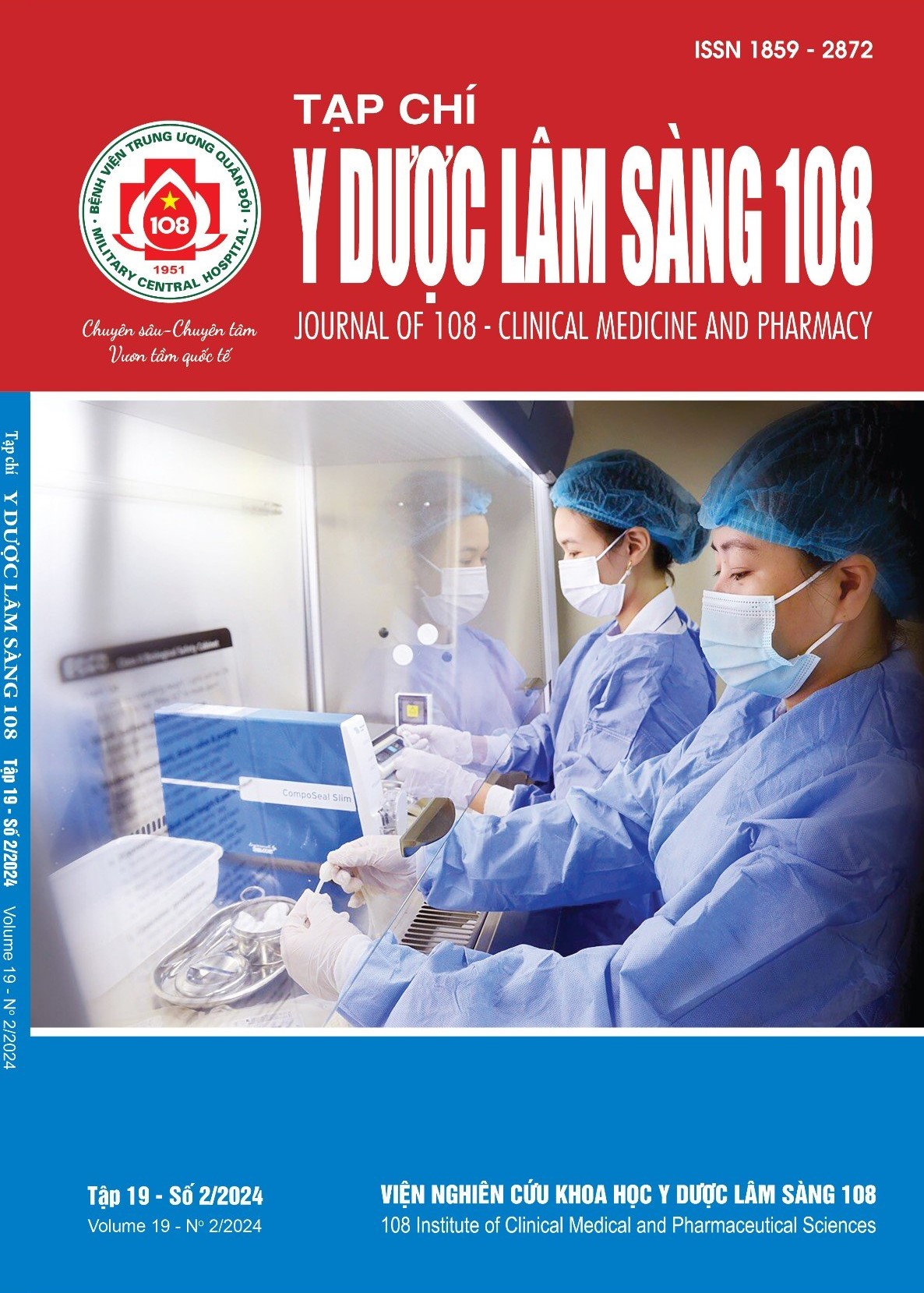Comparison of the efficacy of drug-eluting bead transarterial chemoembolization (DEB-TACE) vs conventional TACE hepatocellular carcinoma (HCC) by LIRADS v2018 on CT
Main Article Content
Keywords
Abstract
Objective: This study aimed to compare the effectiveness of drug-eluting bead transarterial chemoembolization (TACE) vs conventional TACE in treating hepatocellular carcinoma patients. Subject and method: A cross-sectional, retrospective descriptive study used the LR-TR critical on computer tomography (CT) to compare the treatment response after the first TACE in 58 patients with HCC (29 HCC with c-TACE and 29 HCC with Deb-TACE) from June 2021 - September 2022. Result: The mean age of the c-TACE group was 56.9 ± 11.0 years old, and the DEB-TACE group was 61.3 ± 11 years old. There was no significant difference in clinical and laboratory characteristics in patients treated with c-TACE or Deb-TACE. There was no significant difference in the attributes of the located tumor or tumor size between patients treated with DEB-TACE and c-TACE (p>0.05). There was considerable difference in the tumor morphology between patients treated with DEB-TACE and c-TACE groups (p<0.05). For detecting viable tumors, LR-TR non-viable resulted in 31% (18/58), and the LR-TR viable was 69% (40/58). The LR-TR viable in patients with c-TACE was 75% higher than DEB-TACE in 58.6%, with no significant difference with p>0.05. In comparison to the treatment response of c-TACE and DEB-TACE by using LR-TR critical, no significant difference between sensitivity and accuracy value (95.2%/89.6% in c-TACE and 84.2%/86.2% in Deb-TACE), p>0.05. The specificity of LR-TR critical to detecting the efficacy of c-TACE was significantly lower than that of Deb-TACE, p<0.05. Conclusion: The LR-TR algorithm helps assess treatment response post-TACE. The specificity of LR-TR was critical to detecting the efficacy of c-TACE, which was significantly lower than that of Deb-TACE. The sensitivity and the accuracy of the LR-TR algorithm were not significant differences in evaluating effectiveness between the two groups.
Article Details
References
2. Bzeizi KI, Arabi M, Jamshidi N et al (2021) Conventional Transarterial Chemoembolization Versus Drug-Eluting Beads in Patients with Hepatocellular Carcinoma: A Systematic Review and Meta-Analysis. Cancers (Basel) 13(24)doi:10.3390/cancers13246172.
3. Kim SW, Joo I, Kim H-C et al (2020) LI-RADS treatment response categorization on gadoxetic acid-enhanced MRI: Diagnostic performance compared to mRECIST and added value of ancillary features. European Radiology 30(5): 2861-2870. doi:10.1007/s00330-019-06623-9.
4. Heimbach JK, Kulik LM, Finn RS et al (2018) AASLD guidelines for the treatment of hepatocellular carcinoma. Hepatology 67(1): 358-380. doi:10.1002/hep.29086.
5. Galle PR, Forner A, Llovet JM et al (2018) EASL Clinical Practice Guidelines: Management of hepatocellular carcinoma. Journal of Hepatology 69(1): 182-236. doi:10.1016/j.jhep.2018.03.019.
6. Marrero JA, Kulik LM, Sirlin CB et al (2018) Diagnosis, Staging, and Management of Hepatocellular Carcinoma: 2018 Practice Guidance by the American Association for the Study of Liver Diseases. Hepatology 68(2): 723-750. doi:10.1002/hep.29913.
7. Savic LJ, Chapiro J, Funai E et al (2021) Prospective study of Lipiodol distribution as an imaging marker for doxorubicin pharmacokinetics during conventional transarterial chemoembolization of liver malignancies. Eur Radiol 31(5): 3002-3014. doi:10.1007/s00330-020-07380-w.
8. Kudo M, Kawamura Y, Hasegawa K et al (2021) Management of Hepatocellular Carcinoma in Japan: JSH Consensus Statements and Recommendations 2021 Update. Liver Cancer 10(3): 181-223. doi:10.1159/000514174.
9. Savic LJ, Chen E, Nezami N et al (2022) Conventional vs. Drug-Eluting Beads Transarterial Chemoembolization for Unresectable Hepatocellular Carcinoma-A Propensity Score Weighted Comparison of Efficacy and Safety. Cancers (Basel) 14(23). doi:10.3390/cancers14235847.
10. Llovet JM, Lencioni R (2020) mRECIST for HCC: Performance and novel refinements. Journal of Hepatology 72(2): 288-306. doi:10.1016/j.jhep.2019.09.026.
11. Chernyak V, Fowler KJ, Kamaya A et al (2018) Liver Imaging Reporting and Data System (LI-RADS) Version 2018: Imaging of Hepatocellular Carcinoma in At-Risk Patients. Radiology 289(3): 816-830. doi:10.1148/radiol.2018181494.
12. Gregory J, Dioguardi Burgio M, Corrias G, Vilgrain V, Ronot M (2020) Evaluation of liver tumour response by imaging. JHEP Reports 2(3):100100. doi:10.1016/j.jhepr.2020.100100.
13. Wu B, Zhou J, Ling G, Zhu D, Long Q (2018) CalliSpheres drug-eluting beads versus lipiodol transarterial chemoembolization in the treatment of hepatocellular carcinoma: a short-term efficacy and safety study. World Journal of Surgical Oncology 16:69. doi:10.1186/s12957-018-1368-8.
14. Ikeda M, Arai Y, Inaba Y et al (2022) Conventional or Drug-Eluting Beads? Randomized Controlled Study of Chemoembolization for Hepatocellular Carcinoma: JIVROSG-1302. Liver Cancer 11(5):
440-450. doi:10.1159/000525500.
 ISSN: 1859 - 2872
ISSN: 1859 - 2872
